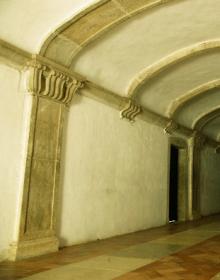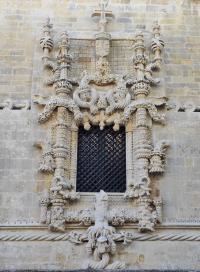- HOME
- MONUMENT
- Convent of Christ
- History
- Architecture
- Personalities
- King Afonso Henriques
- D. Gualdim Pais
- King Dinis
- King John I
- D. Lopo Dias de Sousa
- King Duarte
- Prince D. Henrique (Henry
- King John II (1455 - 1495
- King Manuel I (1469 - 152
- Diogo de Arruda
- João de Castilho
- Jorge Afonso
- Olivier de Gand
- King John III (1502 - 155
- Diogo de Torralva
- Friar Anthony of Lisbon
- Baltazar de Faria
- Filipe Terzi
- Philippine Dinasty
- King Philip II of Spain
- King John IV
- Domingos Serrão
- Queen Mary II
- Prince Fernando
- Costa Cabral
- Artisans and Artists
- Intangible Heritage
- Related Heritage
- Glossary
- VISIT OUR MONUMENT
- HERITAGE LEARNING
- TOMAR
- MONASTERIES ROUTE

The extinction of religious orders and the Convent of Christ
With the Liberal revolution in 1834 the male religious orders were extinct. However, Queen Maria II keeps the Militia of Christ as an honorary Order, with her as the Master. Many of the assets belonging to the extinct Orders were sold at public auctions by the Liberal government; others were kept as historical monuments.
The conventual Wall, the enclosure of the old village in the castle and parts of the buildings of the Ravens Cloister, in the south-western angle of the convent, were sold in 1835. All of these assets were purchased by the influential liberal politician António Costa Cabral to whom the Queen bestowed - at a later date - the nobiliary title of Count of Tomar. The adaptation of the western wing of the Ravens Cloister to a neoclassical mansion is testimony to 19th century architecture and taste. The Count of Tomar and his descendants lived here for many generations.
The remaining constructions of the monument set - belonging to the Crown - constituted about three fifths of the total constructed area; encompassing the castrejo (fortified buildings) and conventual spaces had various roles. In 1876, the Infirmary and Pharmacy became the military hospital - once completely set up in 1909, it remained so until 1993; the buildings that circle the cloister patios of the Lodgings and Micha belonged to a Republican National Guard unit from the beginning of the 20th century until 1935. Other areas on the floors of these cloisters were transformed into residencies for military officers and civil servants up until 1921- they began abandoning these spaces with the arrival to the convent of the Portuguese Society Seminar of the Overseas Missions.
In 1934, the State finally acquires from Costa Cabral´s descendants all of the properties - rural and urban alike - that were held by acquirement or possession from their ancestors. The entire monument was then confined to three distinct activities: Cultural - managed by the local association of heritage protection, later constituted as the Union of Friends of the Monuments of the Order of Christ (União dos Amigos dos Monumentos da Ordem de Cristo - UAMOC); Educational and Religious, including worshiping in the conventual church, by the Missionary Society; and the Hospital by the military institution.
In the early 1980´s, the Cultural Secretary of State began to govern the cultural and touristic part of the monument, and in the 1990´s firstly the Missions Seminar followed by the Military Hospital leave the premises. In March 2002, IPPAR (Portuguese Institute for Architectural Heritage) occupies the spaces of the Infirmary and the Pharmacy. The urban part of the monument is now, after 165 years, governed again by a single state body. Seven centuries of history find again its spatial unity, spread throughout approximately 4.5 acres of built area, including castreja constructions and approximately 3.7 acres of usable area, mostly distributed by the four floors of the renaissance convent and including the enclosure wall of the Convent of Christ, with 45 acres - the Seven Hills of Tomar.
The conventual Wall, the enclosure of the old village in the castle and parts of the buildings of the Ravens Cloister, in the south-western angle of the convent, were sold in 1835. All of these assets were purchased by the influential liberal politician António Costa Cabral to whom the Queen bestowed - at a later date - the nobiliary title of Count of Tomar. The adaptation of the western wing of the Ravens Cloister to a neoclassical mansion is testimony to 19th century architecture and taste. The Count of Tomar and his descendants lived here for many generations.
The remaining constructions of the monument set - belonging to the Crown - constituted about three fifths of the total constructed area; encompassing the castrejo (fortified buildings) and conventual spaces had various roles. In 1876, the Infirmary and Pharmacy became the military hospital - once completely set up in 1909, it remained so until 1993; the buildings that circle the cloister patios of the Lodgings and Micha belonged to a Republican National Guard unit from the beginning of the 20th century until 1935. Other areas on the floors of these cloisters were transformed into residencies for military officers and civil servants up until 1921- they began abandoning these spaces with the arrival to the convent of the Portuguese Society Seminar of the Overseas Missions.
In 1934, the State finally acquires from Costa Cabral´s descendants all of the properties - rural and urban alike - that were held by acquirement or possession from their ancestors. The entire monument was then confined to three distinct activities: Cultural - managed by the local association of heritage protection, later constituted as the Union of Friends of the Monuments of the Order of Christ (União dos Amigos dos Monumentos da Ordem de Cristo - UAMOC); Educational and Religious, including worshiping in the conventual church, by the Missionary Society; and the Hospital by the military institution.
In the early 1980´s, the Cultural Secretary of State began to govern the cultural and touristic part of the monument, and in the 1990´s firstly the Missions Seminar followed by the Military Hospital leave the premises. In March 2002, IPPAR (Portuguese Institute for Architectural Heritage) occupies the spaces of the Infirmary and the Pharmacy. The urban part of the monument is now, after 165 years, governed again by a single state body. Seven centuries of history find again its spatial unity, spread throughout approximately 4.5 acres of built area, including castreja constructions and approximately 3.7 acres of usable area, mostly distributed by the four floors of the renaissance convent and including the enclosure wall of the Convent of Christ, with 45 acres - the Seven Hills of Tomar.
SERVICES - ACTIVITIES



